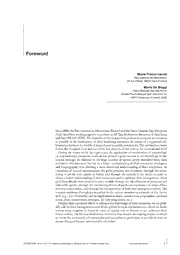Table Of ContentForeword
Marie-France Leccia
Parc national du Mercantour,
23 rue d’Italie, 06000 Nice (France)
Marta De Biaggi
Parco Naturale Alpi Marittime,
Strada Provinciale per San Giacomo 12,
12010 Entracque (Cuneo), (Italy)
Since 2006, the Parc national du Mercantour (France) and the Parco Naturale Alpi Marittime
(Italy) have been working together to produce an All Taxa Biodiversity Inventory of their fauna
and flora (M-AM ATBI). The objective of this project is to produce as complete an inventory
as possible of the biodiversity of these bordering territories, by means of a supported col-
laboration between the worlds of research and naturalist associations. This represents a major
first at the European level and one of the few projects of this scale at the international level!
During the course of the last eight years, the application of combination of morphologi-
cal and molecular taxonomic methods has allowed a great increase in our knowledge of this
natural heritage. In addition to the large number of species newly identified from these
territories, this inventory has led to a better understanding of their taxonomy, phylogeny
and biogeography, thus allowing a more functional understanding of their ecosystems. As
custodians of natural environments, the parks promote this inventory, through the moni-
toring of certain sites, species or habits, and through the analysis of the results in order to
obtain a better understanding of their ecosystems and to optimise their management. These
goals have already been attained in part, notably through the identification of protected and
vulnerable species, through the monitoring of sites of particular importance in terms of bio-
diversity conservation, and through the incorporation of both into management plans. This
impetus continues through participation in the various monitoring networks at the Alpine
level (e.g., Lacs Sentinelles) and an implication in many conservation programmes (national
action plans, conservation strategies, the Life programme, etc.).
Despite these concerted efforts to advance our knowledge of these territories, we are prob-
ably still far from having inventoried all the species living in our mountains, which no doubt
reserve many surprises in future in terms of species new to Science or yet unknown from
France or Italy. The All Taxa Biodiversity Inventory thus remains an ongoing project, in which
we invite the community of taxonomists and naturalists to participate at our side in order to
pursue this great human and scientific adventure!
5
ZOOSYSTEMA • 2015 • 37 (1) © Publications scientifiques du Muséum national d’Histoire naturelle, Paris. www.zoosystema.com
Avant-propos
Marie-France Leccia
Parc national du Mercantour,
23 rue d’Italie, 06000 Nice (France)
Marta De Biaggi
Parco Naturale Alpi Marittime,
Strada Provinciale per San Giacomo 12,
12010 Entracque (Cuneo), (Italy)
Depuis 2006, le Parc national du Mercantour (France) et le Parco Naturale Alpi Marittime
(Italie) œuvrent ensemble au pilotage de leur Inventaire Biologique Généralisé (IBG M/AM).
Ce projet a pour objectif premier d’inventorier de la manière la plus exhaustive possible la bio-
diversité de ces deux territoires frontaliers, grâce à une collaboration soutenue avec le monde
de la recherche et les associations naturalistes. Une grande première au niveau européen et
un des rares projets de cette envergure à l’échelle internationale !
Au cours de ces huit dernières années, la combinaison des approches morphologique et
moléculaire de la systématique, a permis un net accroissement de la connaissance de ce patri-
moine naturel. Outre l’augmentation considérable du nombre d’espèces recensées sur ces
territoires, cet inventaire aboutit aussi à une meilleure compréhension de la taxonomie, de
la phylogénie et de la biogéographie de ces espèces et une vision plus fonctionnelle de leurs
écosystèmes. En tant que gestionnaires d’espaces naturels, les parcs valorisent cet inventaire,
d’une part à travers le suivi de certains sites, espèces ou habitats, d’autre part par l’analyse
des données acquises dans une optique de meilleure compréhension de leurs écosystèmes
et d’optimisation de leur gestion. Cette ambition s’est déjà concrétisée, notamment, par
l’identification d’espèces protégées et vulnérables, par le suivi de certains sites considérés
comme prioritaires en termes d’enjeux de conservation et par la prise en compte de ces espèces
et sites prioritaires dans les plans de gestion. Cette dynamique se poursuit également à travers
la participation à divers réseaux de suivi à l’échelle alpine (Lacs Sentinelles par exemple) et
l’investissement dans de nombreux programmes de conservation (plans nationaux d’action,
stratégies conservatoires, programmes Life, etc.).
Malgré ces efforts soutenus pour faire progresser la connaissance de nos territoires, nous
sommes probablement loin d’avoir recensé l’intégralité des espèces vivants dans nos mon-
tagnes et celles-ci nous réservent encore certainement des surprises en terme d’espèces restants
à décrires sur les territoires français et italiens. L’Inventaire Biologique Généralisé reste donc
un projet d’actualité, sur lequel nous invitons la communauté taxonomique et naturaliste à
s’investir à nos côtés et à poursuivre cette grande aventure humaine et scientifique !
7
ZOOSYSTEMA • 2015 • 37 (1) © Publications scientifiques du Muséum national d’Histoire naturelle, Paris. www.zoosystema.com

